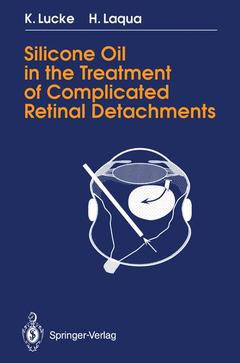Silicone Oil in the Treatment of Complicated Retinal Detachments, Softcover reprint of the original 1st ed. 1990 Techniques, Results, and Complications
Langue : Anglais
Auteurs : Lucke Klaus, Laqua Horst

Silicone oil was introduced into ophthalmic surgery by Paul Cibis in the early 1960's in an attempt to treat giant retinal tears and cases where retinal detachment had failed to respond to conventional scleral buckling tech niques. His understanding of the nature of vitreous pathology and how it related to complex retinal detachment laid the foundation for modern vit reoretinal surgery. Cibis's success with these problems together with his rationale for sepa rating membranes from the retina led others to try their hand at learning his techniques. At the same time much criticism was levelled at the concept of injecting what was regarded as a foreign material into the eye, as well as to the whole idea of operating within the vitreous cavity. Some of this was personal, some due to a lack of understanding of the underlying pathology and some due to disappointment following surgical failure us ing the new methods. Early results were certainly encouraging but it was not until the advent of pars plana vitrectomy that it became possible to develop more refined methods in combination with the use silicone oil so that much better results could be obtained.
1 Introduction.- 1.1 Conventional Retinal Surgery.- 1.2 Vitreous Surgery.- 1.3 Extreme Vitreoretinal Surgery.- 1.3.1 Silicone Oil in Retinal Surgery.- 1.3.2 Long-Acting Gases.- 2 Materials and Methods.- 2.1 Silicone Oils.- 2.1.1 Properties of Silicone Oils.- 2.1.2 Hypotheses On the Mode of Action of Silicone Oil.- 2.2 Patients.- 2.2.1 Description of the Sample Investigated.- 2.2.2 Distribution of Indications.- 2.3 Surgical Techniques.- 2.3.1 General.- 2.3.2 Special Surgical Techniques for Various Indications.- 2.3.3 Special Techniques.- 2.4 Statistical Method.- 2.4.1 Clinical Examinations and Observation Intervals.- 2,4.2 Life Table Analysis.- 2.4.3 Definitions.- 3 Results.- 3.1 Anatomic and Functional Results.- 3.1.1 Anatomic Success.- 3.1.2 Visual Success.- 3.1.3 Preservation of Ambulatory Vision.- 3.1.4 Poor Visual Acuity in Spite of Attached Retina.- 3.1.5 Development of Visual Acuity.- 3.2 Special Problems.- 3.2.1 Number of Operations.- 3.2.2 Results After Silicone Oil Removal.- 3.2.3 Timing of Silicone Oil Removal.- 3.3 Complications.- 3.3.1 Intraoperative Complications.- 3.3.2 Postoperative Complications.- 3.4 Influence of Special Factors on Results and Complications.- 3.4.1 Aphakia.- 3.4.2 Inferior Basal Iridectomy (“Ando Iridectomy”).- 3.4.3 Silicone Oil Removal.- 3.4.4 Retinectomy.- 3.4.5 Comparison of Surgeons.- 4 Discussion.- 4.1 Results.- 4.1.1 General Aspects.- 4.1.2 Results by Indication Groups.- 4.1.3 Complications.- 4.1.4 Retinal Toxicity.- 4.1.5 Aphakia.- 4.1.6 Silicone Oil Removal.- 4.1.7 Retinectomy.- 4.2 Legal Use of Silicone Oil.- 4.3 Alternative Substances.- 4.4 Summary.- References.
Date de parution : 01-2012
Ouvrage de 161 p.
15.5x23.5 cm
Disponible chez l'éditeur (délai d'approvisionnement : 15 jours).
Prix indicatif 52,74 €
Ajouter au panierThème de Silicone Oil in the Treatment of Complicated Retinal... :
Mots-clés :
complication; complications; diabetes; pathology; patients; retina; surgery; treatment
© 2024 LAVOISIER S.A.S.



